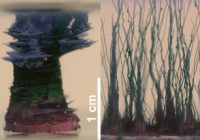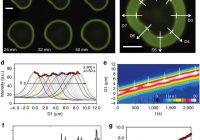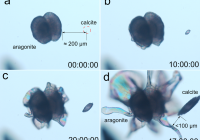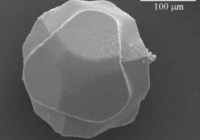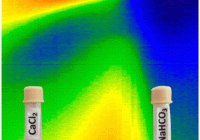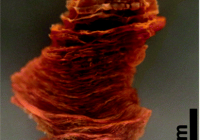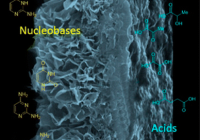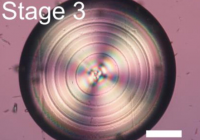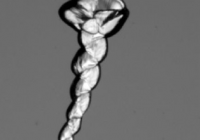Glaab, F.; Rieder, J.; Klein, R.; Choquesillo-Lazarte, D.; Melero-Garcia, E.; Garcia-Ruiz, J. M.; Kunz, W.; Kellermeier, M., Precipitation and Crystallization Kinetics in Silica Gardens. Chemphyschem 2017, 18 (4), 338-345. Download paper. Silica gardens are extraordinary plant‐like structures resulting from the complex interplay of relatively simple inorganic components. Recent work has highlighted that macroscopic self‐assembly is accompanied by the spontaneous formation of considerable chemical gradients, which induce a cascade of coupled dissolution, diffusion, and precipitation processes…
Read MorePublications
Local pH oscillations witness autocatalytic self-organization of biomorphic nanostructures
M. Montalti, G. Zhang, D. Genovese, J. Morales, M. Kellermeier & J.M. García-Ruiz, Nat Commun. 2017 Feb 16;8:14427. Download paper. Bottom-up self-assembly of simple molecular compounds is a prime pathway to complex materials with interesting structures and functions. Coupled reaction systems are known to spontaneously produce highly ordered patterns, so far observed in soft matter. Here we show that similar phenomena can occur during silica-carbonate crystallization, the emerging order being preserved. The resulting materials, called…
Read MoreGrowth behaviour of silica/carbonate nanocrystalline composites of calcite and aragonite
Gan Zhang, Juan Morales and Juan Manuel García-Ruiz, J. Mater. Chem. B, 2017, 5, 1658. Download paper. The precipitation of barium and strontium carbonate in alkaline silica gels or silica solutions produces nanocrystalline self-assembled composite materials displaying biomimetic shapes and textures. We have crystallized concomitantly in time and space two anhydrous polymorphs of calcium carbonate, under similar conditions at different temperatures. The orthorhombic phase aragonite produces nanocrystalline aggregates exhibiting non-crystallographic morphologies and complex textures characteristic…
Read MoreThree study cases of growth morphology in minerals: Halite, calcite and gypsum
Aquilano, D.; Otálora, F.; Pastero, L.; García-Ruiz, J. M., Progress in Crystal Growth and Characterization of Materials 2016, 62 (2), 227-251. Download paper. Beyond fundamental aspects of crystal growth and morphology, the growth of minerals is a challenging subject because in most cases we face a problem with unknown growth conditions. Actually, in the field of geological studies, we have to decipher the growth conditions of a crystal using the information contained in the very…
Read MoreThe role of CaCO3o neutral pair in calcium carbonate crystallization
Genovese, D.; Montalti, M.; Otálora, F.; Gómez-Morales, J.; Sancho-Tomás, M.; Falini, G.; García-Ruiz, J. M., Crystal Growth & Design 2016. Download paper. The molecular structure of the units that get incorporated into the nuclei of the crystalline phase and sustain their growth is a fundamental issue in the pathway from a supersaturated solution to the formation of crystals. Using a fluorescent dye we have recorded the variation of the pH value in time along a…
Read MoreDiffusion and Precipitation Processes in Iron-Based Silica Gardens
Glaab, F.; Rieder, J.; Garcia-Ruiz, J. M.; Kunz, W.; Kellermeier, M., Physical Chemistry Chemical Physics 2016. Download paper. Silica gardens are tubular structures that form along the interface of multivalent metal salts and alkaline solutions of sodium silicate, driven by a complex interplay of osmotic and buoyant forces together with chemical reaction. They display peculiar plant-like morphologies and thus can be considered as one of the few examples for the spontaneous biomimetic self-ordering of purely…
Read MoreA Global Scale Scenario for Prebiotic Chemistry: Silica-Based Self-Assembled Mineral Structures and Formamide
Saladino, R.; Botta, G.; Bizzarri, B. M.; Di Mauro, E.; Garcia Ruiz, J. M., Biochemistry 2016, 55 (19), 2806-2811. Download paper. The pathway from simple abiotically made organic compounds to the molecular bricks of life, as we know it, is unknown. The most efficient geological abiotic route to organic compounds results from the aqueous dissolution of olivine, a reaction known as serpentinization (Sleep, N.H., et al. (2004) Proc. Natl. Acad. Sci. USA 101, 12818–12822). In…
Read MoreGrowth Behavior of Monohydrocalcite (CaCO3·H2O) in Silica-Rich Alkaline Solution
Zhang, G.; Delgado-López, J. M.; Choquesillo-Lazarte, D.; García-Ruiz, J. M., Crystal Growth & Design 2015, 15 (2), 564-572. Download paper. Monohydrocalcite (CaCO3·H2O) has been crystallized in silica-rich alkaline water solution. The crystallization proceeds by a counterdiffusion method without the presence of any other additive except dissolved silica. The crystallization has been followed in situ by optical microscopy and Raman microspectroscopy, while the time evolution of the pH and the concentration of calcium and silica species…
Read MoreCrystallization of monohydrocalcite in silica-rich alkaline solution at different temperatures
Zhang, G.; Morales, J.; Verdugo-Escamilla, C.; García-Ruiz, J. M., Macla 2015, 20, 153-154. Here, we present the morphological study of the silica-calcium monohydrocalcite biomorphs obtained at different temperatures. [Download paper]
Read MoreSobre los Experimentos de Creación de Vida de Andrew Crosse
Garcia-Ruiz, J. M., Macla 2015, 20, 61-62. Uno de los personajes más exitosos y conocidos de la historia de la literatura y el cine de ficción es el creado por la escritora Mary Shelley en 1817 en su libro “Frankenstein o el moderno Prometeo”. Paradójicamente, uno de los científicos menos conocidos y más misteriosos de la historia de la ciencia británica es Andrew Crosse, el individuo real en el que, según se suele afirmar, Mary…
Read More

